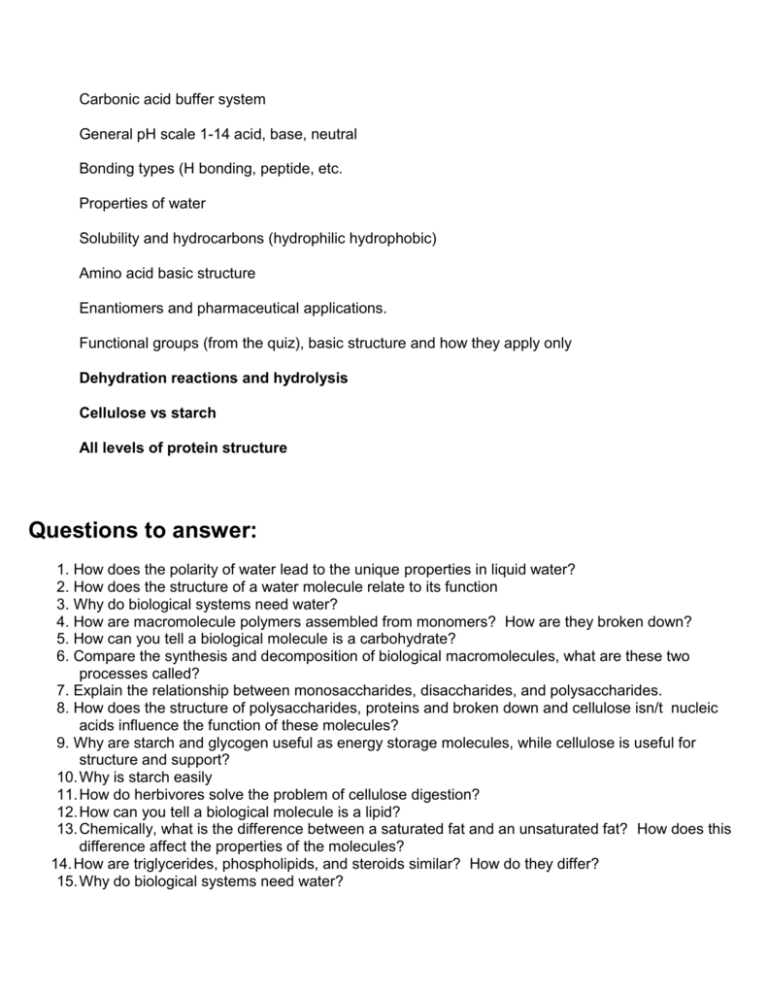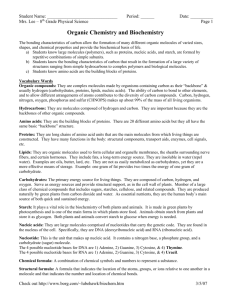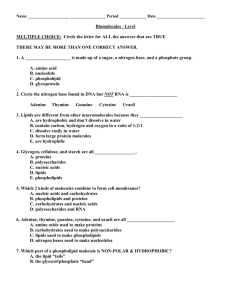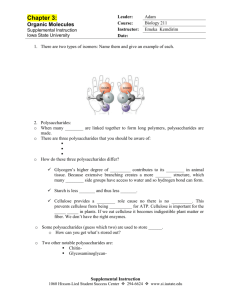biochemistry review topics
advertisement

Carbonic acid buffer system General pH scale 1-14 acid, base, neutral Bonding types (H bonding, peptide, etc. Properties of water Solubility and hydrocarbons (hydrophilic hydrophobic) Amino acid basic structure Enantiomers and pharmaceutical applications. Functional groups (from the quiz), basic structure and how they apply only Dehydration reactions and hydrolysis Cellulose vs starch All levels of protein structure Questions to answer: 1. How does the polarity of water lead to the unique properties in liquid water? 2. How does the structure of a water molecule relate to its function 3. Why do biological systems need water? 4. How are macromolecule polymers assembled from monomers? How are they broken down? 5. How can you tell a biological molecule is a carbohydrate? 6. Compare the synthesis and decomposition of biological macromolecules, what are these two processes called? 7. Explain the relationship between monosaccharides, disaccharides, and polysaccharides. 8. How does the structure of polysaccharides, proteins and broken down and cellulose isn/t nucleic acids influence the function of these molecules? 9. Why are starch and glycogen useful as energy storage molecules, while cellulose is useful for structure and support? 10. Why is starch easily 11. How do herbivores solve the problem of cellulose digestion? 12. How can you tell a biological molecule is a lipid? 13. Chemically, what is the difference between a saturated fat and an unsaturated fat? How does this difference affect the properties of the molecules? 14. How are triglycerides, phospholipids, and steroids similar? How do they differ? 15. Why do biological systems need water? 16. Why are proteins the most complex biological molecules? 17. Draw the structure of a general amino acid. Label the carboxyl group, the amino group, and the variable (‘R’) group. 18. Draw the formation of a peptide bond between two amino acids. 19. How does the structure of the ‘R’ group affect the properties of a particular amino acid? 20. Define each of the following levels of protein structure and explain the bonds that contribute to them: Primary Secondary Tertiary Quaternary 21. How does the sequence of amino acids in a protein determine ach level of that proteins structure? 22. How can the structure of a protein be changed (“denatured”)? What factors affect denaturing? 23. Draw a nucleotide. Label the phosphate, sugar, and nitrogenous base. 24. Explain the three major structural differences between RNA and DNA. Things you should make sure you understand: The chemical differences between the carbohydrates and lipids. The roles played by carbohydrates and lipids in biological systems. How the structure of proteins and nucleic acids allow for their biological functions. How both protein structure and nucleic acid structure illustrate the concepts of emergence and combinatorial complexity. Why directionality and sequence are crucial for the structure and function of proteins and nucleic acids. How nucleic acids and proteins function in storage and expression of biological information.











